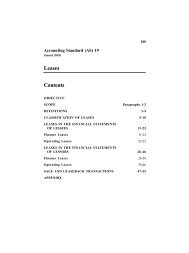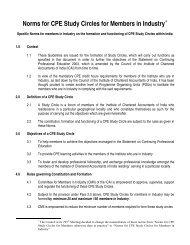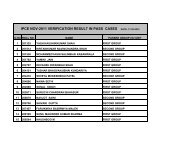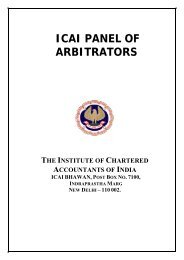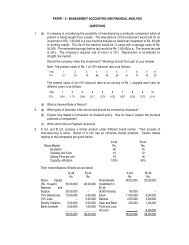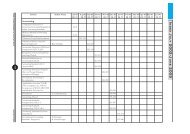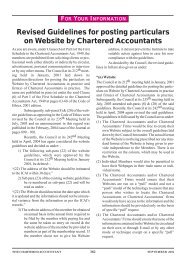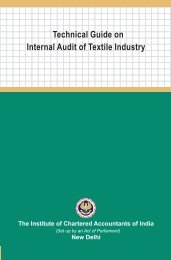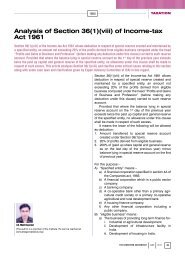The Chartered Accountant
The Chartered Accountant
The Chartered Accountant
You also want an ePaper? Increase the reach of your titles
YUMPU automatically turns print PDFs into web optimized ePapers that Google loves.
forcing otherwise healthy banks to write down their<br />
assets because another, more sickly bank had to dump<br />
similar assets in a fire sale. MtM, he argued, was one<br />
reason that all MBS were affected by a relatively low<br />
rate of mortgage defaults (6.4% versus 40% during<br />
the Great Depression). 16 <strong>The</strong> pro-cyclical effect of<br />
MtM, critics say, intensifies the business cycle, fostering<br />
economic instability, allowing banks to loan more<br />
in the good times, but devastating them in the bad<br />
times. 17 Proponents of MtM, including Treasury Secretary<br />
Henry Paulson, believe that banks should have<br />
the discipline to record their assets at fair value. 18 <strong>The</strong><br />
debate continues whether mark-to-market was a cause<br />
of the crisis or just an accurate barometer of it.<br />
Soon retail banks found that they could not meet the<br />
capital adequacy requirements set by regulators as<br />
their assets were declining rapidly in value. To meet<br />
regulatory requirements, they had to raise capital, but<br />
capital was increasingly scarce. With inadequate capital<br />
to cover the loans already on their books, banks<br />
simply could not loan more money. Since most financial<br />
institutions were in the same boat, the entire<br />
credit market ground to a halt. Other types of loans,<br />
such as corporate short term loans, credit cards, auto<br />
loans, and student loans were affected. Municipalities<br />
delayed bond issuances in fear that they would not<br />
be able to raise needed capital to meet their budgets.<br />
Automakers’ sales started to plummet because people<br />
could not finance new cars. Not surprisingly, the U.S.<br />
stock market began a long and unchecked downward<br />
slide, eventually losing 40% of its value from October<br />
2007 to October 2008.<br />
Taxpayers to the rescue<br />
On October 3, 2008, in an attempt to finally stop the<br />
panic, the US Congress passed a $700 billion bailout<br />
package. <strong>The</strong> bailout package, officially called<br />
the Emergency Economic Stabilization Act (EESA),<br />
enabled the Treasury to broadly intervene in private<br />
companies in order to purchase their MBS, give them<br />
access to capital, and allow them to obtain government<br />
loans. <strong>The</strong> $700 billion could be used to aid the<br />
economy in three ways:<br />
1. Provide liquidity to consumer and commercial<br />
credit markets and foreclosure intervention<br />
2. Capital Purchases – purchase non-voting equity<br />
DECEMBER 2008 1012 THE CHARTERED ACCOUNTANT<br />
GLOBAL PERSPECTIVE<br />
stakes (preferred stock) in the company in exchange<br />
for capital<br />
3. Direct Aid or Loans to Failing Institutions – direct<br />
assistance through loans with terms negotiated<br />
on a case-by-case basis<br />
In return for the assistance, the Treasury placed restrictions<br />
on executive pay, including caps on tax<br />
deductibility, limits on incentives that “encourage<br />
unnecessary and excessive risks”, a ban or limit on<br />
severance packages, and the ability in some cases to<br />
recoup or clawback compensation already paid out.<br />
<strong>The</strong>se pay provisions were in response to the public<br />
outcry that the bailout would spend US taxpayer<br />
money to rescue companies when their executives<br />
pocketed millions of dollars in bonuses, stock awards,<br />
and golden parachutes.<br />
<strong>The</strong> Federal Deposit Insurance Corporation (FDIC)<br />
of the US government is also guaranteeing unsecured<br />
credit issued by financial institutions for a fee. Ultimately,<br />
the US tax payers will be on the hook if these<br />
financial institutions default and the US government<br />
is forced to make good on its guarantee. Whether the<br />
fee charged by the FDIC is adequate to cover this risk<br />
will be known only in the future and will depend, in<br />
part, on how deep the current recession will last.<br />
Who’s to Blame?<br />
We have already discussed the role of the run-up and<br />
the eventual crash in real estate prices, the unsustainable<br />
euphoria that accompanies bubble markets, the<br />
securitization of home mortgages, and the low interest<br />
rate environment as factors that set the stage<br />
for the financial meltdown. While all this created a<br />
nice dry tinder box, who or what set the match to<br />
it? Upon review of the suspects, nearly every entity<br />
that was involved in the subprime crisis bears some<br />
blame.<br />
<strong>The</strong> US government bears responsibility for the poor<br />
oversight and regulation of both the subprime and<br />
the CDS market. In particular, the former Federal<br />
Reserve Chairman, Alan Greenspan, decided not to<br />
regulate the CDS market and has since regretted his<br />
decision in testimony before the Congress. A central<br />
clearing house and more transparency in what was<br />
being bought and sold in the CDS over-the-counter<br />
(OTC) market may have helped to avoid the credit<br />
16Berlau, John, “Maybe the Banks Are Just Counting Wrong,” <strong>The</strong> Wall Street Journal, September 20, 2008, http://online.wsj.com/article/SB122186515562158671.html,<br />
accessed November 12, 2008.<br />
17JPMorgan, “Solvency, mark-to-market and insurance,” webpage, http://www.jpmorganchase.com/cm/ContentServer?c=JPM_Content_C&pagename=jpmorgan%2Fam<br />
%2FJPM_Content_C%2FGeneric_Detail_Page_Template&cid=1159362822564, accessed November 12, 2008.<br />
18Michael Grynbaum, “Paulson Weighs In on Mark-to-Market Debate,” New York Times DealBook Blog, July 22, 2008, http://dealbook.blogs.nytimes.com/2008/07/22/<br />
paulson-weighs-in-on-mark-to-market-debate/, accessed November 12, 2008.



